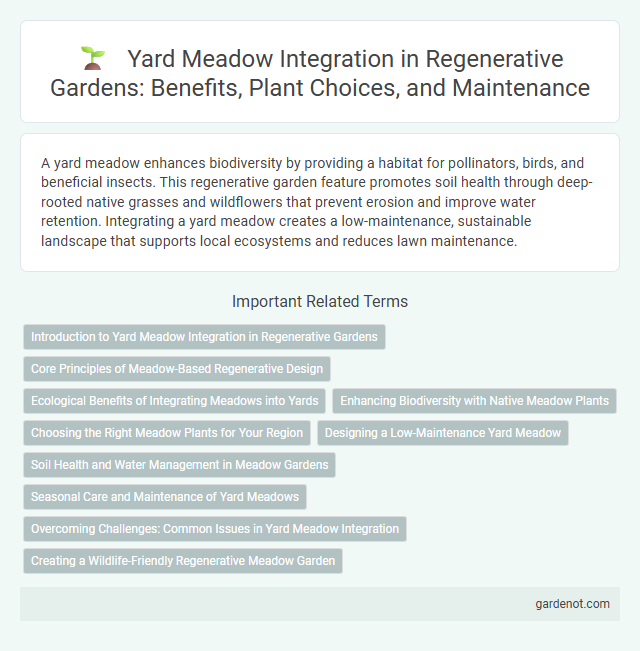A yard meadow enhances biodiversity by providing a habitat for pollinators, birds, and beneficial insects. This regenerative garden feature promotes soil health through deep-rooted native grasses and wildflowers that prevent erosion and improve water retention. Integrating a yard meadow creates a low-maintenance, sustainable landscape that supports local ecosystems and reduces lawn maintenance.
Introduction to Yard Meadow Integration in Regenerative Gardens
Yard meadows enhance regenerative gardens by supporting native biodiversity and improving soil health through native grasses and wildflowers. Integrating yard meadows reduces water usage and creates habitats for pollinators, fostering a resilient ecosystem. This approach promotes natural nutrient cycling and mitigates erosion while maintaining vibrant, low-maintenance landscapes.
Core Principles of Meadow-Based Regenerative Design
Yard meadow design centers on core principles of biodiversity, soil health, and native plant integration to create resilient ecosystems. Emphasizing deep root systems and minimal disturbance enhances carbon sequestration and water retention. This regenerative process supports pollinators, improves soil structure, and fosters natural habitat connectivity.
Ecological Benefits of Integrating Meadows into Yards
Integrating meadows into yards enhances biodiversity by providing habitat for pollinators and native wildlife, supporting local ecosystems. These meadows improve soil health through deep-rooted native plants that reduce erosion and promote nutrient cycling. Additionally, yard meadows contribute to water conservation by increasing infiltration and reducing runoff compared to traditional lawns.
Enhancing Biodiversity with Native Meadow Plants
Native meadow plants in a regenerative garden create a thriving habitat for pollinators, birds, and beneficial insects, boosting local biodiversity. These plants improve soil health through deep root systems that enhance aeration and water retention while reducing erosion. Integrating diverse native species fosters resilient ecosystems and supports sustainable yard meadows.
Choosing the Right Meadow Plants for Your Region
Selecting meadow plants adapted to your region's climate and soil conditions enhances the success of a regenerative yard meadow. Native grasses like little bluestem in dry areas or switchgrass in wetter zones provide resilience and support local biodiversity. Incorporating a mix of wildflowers and legumes, such as black-eyed Susan and purple clover, further improves soil health and attracts pollinators essential for ecosystem balance.
Designing a Low-Maintenance Yard Meadow
Designing a low-maintenance yard meadow emphasizes selecting native wildflowers and grasses adapted to local climate and soil conditions to reduce water and nutrient needs. Incorporating diverse perennial species supports pollinators and soil health while minimizing mowing and weeding requirements. Proper site preparation, including removing invasive plants and optimizing soil structure, enhances meadow establishment and long-term sustainability.
Soil Health and Water Management in Meadow Gardens
Yard meadows enhance soil health by increasing organic matter and promoting beneficial microbial activity, which improves nutrient cycling and soil structure. Deep-rooted native plants optimize water management by enhancing infiltration, reducing runoff, and increasing water retention in meadow gardens. These practices create resilient ecosystems that support biodiversity and maintain balanced hydrology in regenerative gardens.
Seasonal Care and Maintenance of Yard Meadows
Yard meadows require seasonal care focused on promoting native plant growth and supporting local biodiversity. Regular mowing should be timed to avoid peak flowering periods, usually late summer, to encourage seed dispersal and habitat for pollinators. Spring and fall are key seasons for overseeding native grasses and wildflowers to maintain a healthy, resilient meadow ecosystem.
Overcoming Challenges: Common Issues in Yard Meadow Integration
Yard meadow integration often faces challenges such as poor soil quality, invasive weed species, and inconsistent moisture levels that hinder native plant establishment. Effective solutions involve amending soil with organic matter, implementing targeted weed management strategies, and optimizing irrigation to support diverse meadow flora. Addressing these issues ensures improved biodiversity, soil health, and resilience in a regenerative yard meadow ecosystem.
Creating a Wildlife-Friendly Regenerative Meadow Garden
A wildlife-friendly regenerative meadow garden enhances biodiversity by incorporating native grasses, wildflowers, and pollinator-friendly plants that provide habitat and food sources for birds, insects, and small mammals. Incorporating features such as logs, rocks, and water sources supports diverse species and encourages natural ecological cycles. Regularly managed mowing schedules promote native plant growth while suppressing invasive species, maintaining a balanced and thriving meadow ecosystem.
Yard meadow Infographic

 gardenot.com
gardenot.com